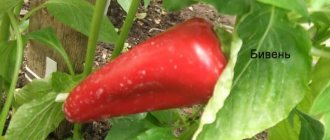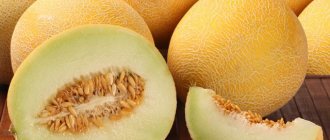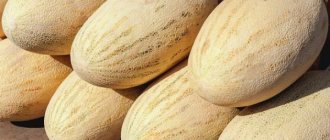The homeland of melon is considered to be India and the countries of Asia Minor and Central Asia. This melon crop is a source of vitamins, macro- and microelements, amino acids. Melon seeds are rich in substances that strengthen the immune system, help cleanse the body, and improve the condition of the skin, hair and nails. A small piece of melon contains half the daily dose of vitamin C. The nutritional value, juiciness and amazing taste of melon make it in demand among owners of summer cottages. Among the variety of varieties, Ethiopian is in great demand.
Sorry, there are no surveys available at this time.
Description of the variety and characteristics
If we refer to the reviews of experienced summer residents, the conclusion follows that the Ethiopian melon occupies a leading position among other varieties. This variety belongs to mid-season crops. It is resistant to diseases and is not afraid of bright sunlight. Ethiopian melon can be grown in two ways: in open ground and in a greenhouse.
This variety is characterized by powerful bushes with heart-shaped leaves. The weight of the fruit is 2-4 kg (if you reduce the number of ovaries, you can achieve a weight of 7 kg). Ripening time is 70-80 days. The melon fruits of this variety resemble a pumpkin in appearance, have a round-oval shape, and are divided into segments. The dense peel, covered with a mesh, avoids problems during transportation and ensures long-term storage.
The juicy melon pulp is light yellow in color. Ripe melon has a sweet, honeyed taste and releases an incredible aroma.
How to grow your own in the garden
Most varieties require approximately the same growing conditions. Melons grow well in warm weather, with plenty of sunshine and plenty of water. Under the right conditions, you will get a high yield: up to 6 ripe fruits from one bush.
Melons are quite delicate plants, so in the northern regions they are grown in a greenhouse. They also need a good dose of fertilizer when planted in the ground and during the growing season.
Planting technology:
- Wait for the air and soil to warm up. By the time of planting in the ground, the soil should warm up above +14°C, and the air - up to +21°C. In temperate climates, sowing is carried out from late May to early June. Do not plant plants if there is a danger of frost: the seeds will not germinate or will die.
- Prepare a landing site. The depth of the pits is about 0.3 m. The distance between them is about 0.51 m.
- Sow 5-6 seeds in each hole. There should be a distance of 10–15 cm between them.
- Protect your crops from pests and weeds with a layer of mulch. Create film shelters in order to optimize the microclimate near the seedlings.
Deadlines
In most temperate regions, the soil freezes deeply in the winter and warms slowly in the spring. And melons must grow in warm soil to form strong bushes.
From emergence to harvest, Ethiopian grows in about 70–80 days. Therefore, it is advisable to plant seedlings in April, so that at the end of May they can be planted in the ground or in a greenhouse. The air temperature in the room should not fall below +20° C, humidity - about 60%. Melon can be planted in the ground until mid-June. Such a crop will have time to grow and ripen before September.
Did you know? Breeders have obtained a cubic melon shape. This type of fruit requires less effort to pack and transport compared to round fruits. But such a melon also costs more.
Site selection and crop rotation
The acidity of ideal soil is 6.0–6.8 pH. Choose a sunny, well-ventilated area. The soil must be drained to ensure better development of the root system. If the area is acidified, add dolomite flour or lime to the soil to deoxidize it. The air temperature at the time of planting should be at least +21° C, the soil temperature +13° C at a depth of 10 cm. Before planting, cover the bed with a dark film to speed up warming up.
In order to increase the nutritional value of the soil, you need to add rotted manure or humus to each hole when planting. Do not use fresh manure as it may contain harmful bacteria and cause increased weed growth.
During the growing season, melon consumes a lot of nutrients. Therefore, a special nutrient substrate is prepared for it: 3–5 cm of compost or well-rotted manure and ordinary garden soil. Then feed with fertilizers every 2 weeks.
There is another way of planting - on fresh manure. Dig a hole 0.3 m deep, place 20–22 cm of fresh manure on the bottom, and 10–15 cm of soil with compost on top. This creates a bed of high nitrogen fertilizers, which also generates the additional heat the melon needs to thrive.
The basis of the crop rotation technique is pest control of garden crops. Therefore, potatoes and late cabbage are considered good predecessors of melons. But it would be more correct to plant wheat or legumes in the beds in the fall. Their root system will loosen the soil well and collect the nitrogen contained in it. Autumn planting does not leave time for flowering, which will create a kind of storehouse of nitrogenous compounds for spring planting of melon. The cycle duration for melon and melon crop rotation is 5 years.
Did you know? Melon
—
is the common name for any of the many varieties of sweet fruits in the Cucurbitaceae family. They all grow on vines.
Sowing pattern and depth
Melons need space to thrive. Therefore, planting is carried out at a distance of 1 m from each other. To save space, you can plant plants at a distance of 0.8 m, using a trellis (lattice) for support. The size of the support for 1 plant is about 6 x 2.5 m. It must be located at an angle to the sun. If you place it above a reflective surface, you will increase the amount of light reaching the leaves and protect the plants from the main pest - aphids, which lose orientation in such conditions.
In large areas, the following planting schemes (in meters) are accepted: 2 x 1, 2.8 x 1, 1.5 x 0.7, 1.4 x 1, 1.8 x 1. The proposed distances depend on the track width machine that processes them. When calculating your distance, keep in mind that each plant needs about 1 m of free space.
Seed immersion depth is up to 5 cm in light sandy soils. If the area is clayey, then it is advisable to dilute the soil with sand and other drainage materials. If this is not possible, plant the seeds to a depth of no more than 3 cm.
Growing melon
Seed preparation
Before planting, the seeds need to be sorted. This can be done manually or using a 2-5% salt solution. To select high-quality material, you need to fill the seeds with liquid. Those that have a healthy embryo will sink to the bottom, low-quality grains will float to the surface. The sorted planting material must be washed with clean water.
Preparing seeds for planting also involves carrying out a procedure to disinfect them. To do this, they need to be soaked for half an hour in a non-concentrated solution of potassium permanganate.
One of the heat treatment options also gives a good effect:
- Warming up near a stove, radiator, or in the oven. In this case, they need to be heated for 2-3 hours (temperature 600C).
- Drying in the sun (duration 2-4 days).
- Warming up in a thermos. To do this, pour boiling water over the grains for half an hour.
Diseases and pests
If agricultural practices are violated, the Ethiopian variety is susceptible to diseases. Insects cause significant damage to crops. To protect plantings, it is important to identify the cause of the damage in time.
Main crop diseases:
- Powdery mildew. It looks like white spots, they spread over the leaves and stems. Gradually, the leaves curl and dry out, the fruits become smaller and lose sugar.
- Downy mildew. It appears as yellow-green spots that quickly spread across the leaf blade.
- Fusarium wilt. The leaves become lighter and gray spots appear on them. After 10 days the plant withers and dies.
To combat diseases, special attention is paid to the treatment of seeds and soil for planting. During the growing season, the crop is sprayed with a solution of sulfur, potassium chloride, Oxyx or Topaz.
Advice! Chemicals are used no more than 2 - 4 times per season every 2 weeks. Treatments are stopped 3 weeks before harvesting.
Melon attracts melon aphids, wireworms, cutworms, spider mites and other pests. Insects feed on the sap of the plant, as a result the melon leaves wither and its yield decreases. The drugs Karbofos, Iskra, Fitoverm are used against pests. During the growing season, chemicals are replaced with wood ash and tobacco dust. Good prevention is digging up the soil in the fall, removing plant residues, and observing crop rotation.
Growing seedlings
In the southern regions, you can resort to the seed method of growing melon. Experienced summer residents recommend using the seedling method. An increase in the growing season has a positive effect on yield. Growing through seedlings protects the heat-loving crop from sub-zero temperatures at night, which increases its resistance to diseases.
You can sow seeds in April (in the middle or at the end). It is necessary to select a container for them, the diameter of which will be about 10 cm. You can place 3-4 seeds in one glass (planting depth 4-5 cm). The temperature in the room should be within 24-250C.
Then the crops are watered and covered with film to create a greenhouse effect. As soon as the first shoots are noticeable, the film must be removed and the container with the seedlings exposed to light. It is important not to overdo it with watering and make sure that the plants are not exposed to direct sunlight.
When two leaves appear, you can apply fertilizer to the seedlings. Their concentration should not be high. Mineral complex fertilizers, herbal mash, and Uniflor-bud are suitable for feeding.
Sorry, there are no surveys available at this time.
We organize proper plant care
To obtain a harvest of sweet and aromatic melons, plants require proper care, which includes timely watering, fertilizing and loosening the soil.
Temporary shelter
Temporary shelter is required for seedlings in the first couple of weeks after planting in the garden so that the leaves do not get sunburn and have time to acclimatize. There are no special requirements for the type of construction, but it is worth remembering that the greater the thickness of the film used, the higher the temperature under the shelter. Melons should be covered in a similar way in regions with cold springs.
Watering
The Ethiopian needs regular watering, which is carried out in the morning or evening hours. Water heated in the sun is used for irrigation. In this case, moisture should not fall on the leaves of the plant. Melons do not like excessive moisture, which causes rotting of the fruit.
Feeding
The first fertilizing is applied 2 weeks after planting the seedlings in the garden. During this period, mullein or ammonium nitrate is added under the bushes. When buds begin to form, the process is repeated. During the formation of the ovaries, potassium salt and superphosphate are added, strictly observing the norms recommended in the instructions.
Formation of bushes
With proper formation of bushes, you can get a larger harvest of melons. Immediately after planting in open ground, the main stem of the plants is pinched so that all its energy is directed to the formation of fruits. On each sprout, in addition to one main shoot, 2 branches are left, and the rest are carefully removed. During fruit formation, no more than 5 ovaries are left.
Loosening, mulching the soil
After each watering or heavy rainfall, the soil in the bed where the Ethiopian grows must be loosened. To prevent excessive evaporation of moisture and the growth of weeds, it is advisable to mulch the rows and areas of soil between the bushes. For this purpose, hay, sawdust, straw, and pine needles are used.
See also
Rules for growing and caring for melon in Siberia in open ground
Read
Bedding
The Ethiopian variety can be planted in open soil only after the period of night frosts has passed. Under the influence of sub-zero temperatures and cold winds, the crop may die.
In order for a melon to grow well, it is necessary to provide it with appropriate conditions. First of all, this concerns the soil. It should be fertile, not acidic and rich in organic matter. It is important that the soil easily allows water and air to pass through to the root system.
Important! If you plant a melon on heavy loamy, saline or sandy soil, you can forget about a good harvest.
When the seedlings have 5-6 leaves, this will be a signal that it is time to transplant them to a heated bed or greenhouse. The day before planting, seedlings need to be watered abundantly.
What are the benefits of Ethiopian melon?
Ethiopian melon is rich in vitamins B, C, E. The pulp contains potassium, calcium, iron, iodine, phosphorus. It contains carotene, folic acid, and fiber. More than 90% of the pulp is water, so it quenches thirst well.
The calorie content of Ethiopian melon is 33 - 35 kcal per 100 g of product. At the same time, the content of carbohydrates is 5.2%, proteins – 0.64%, fats – 0.4%. The pulp contains dietary fiber in the amount of 0.9 g for every 100 g.
Beneficial properties of Ethiopian melon for the body:
- normalizes the nervous system;
- has a diuretic effect;
- stimulates the functioning of the stomach and intestines;
- strengthens blood vessels and heart muscle;
- increases immunity;
- helps burn excess fat.
It is not recommended to use Ethiopian melon if you have diabetes, stomach diseases, or individual intolerance. If you have chronic diseases, you should first consult your doctor.
Proper care
Ethiopian melon responds well to light, moisture, and heat. To reap a bountiful harvest, it must be provided with favorable conditions for growth. As soon as the first shoots are visible, it is necessary to cultivate and eliminate all weeds. After 5-8 leaves appear, you should re-cultivate, weed the beds and leave one sprout in each hole.
For irrigation you need to use warm water. The frequency of procedures depends on weather conditions. This melon variety loves water, but excess moisture can cause root rot. In this regard, it is recommended to water if the soil begins to dry out. Melon experiences a special need for moisture during periods of vine formation and fruit growth.
It is necessary to regularly clear the beds of weeds and trim the plants when they are very dense. Melon fruits do not need protection from the sun, but periodically they need to be turned over and placed under them to prevent rotting.
How to choose a ripe melon when buying
Choosing a melon is not easy: the color of the peel cannot tell about the taste of the pulp, and you won’t be able to try several fruits when purchasing.
But there are still a number of recommendations that can help in choosing:
- Inspect the fruit for defects. It should not have stains, cracks or other damage.
- Check the color of the peel. The Ethiopian has a homogeneous one. A shiny skin is a sign of an unripe melon. The texture should be golden or orange in color. Avoid fruits with shades of green or white.
- Pick up a few fruits. Determine the average weight and buy the one that is heavier.
- When tapping a melon, the correct sound should be the same as from a hollow object.
- A good melon smells fresh with a hint of sweetness where the stem is attached.
Did you know? 25% of the melons consumed worldwide are grown in China. More than 8 million tons of melon are produced here every year.
Formation
IMPORTANT! The melon must be shaped. If you do not pinch the crop, this will lead to the fact that it will form barren flowers, without ovaries. In this regard, it is important to promptly eliminate excess shoots so that the plant can direct all its resources to the formation of fruits.
The melon needs to eliminate empty side shoots to form a stem. This process begins after 5-6 leaves appear. The main shoot is pinched over 2-3 leaves. The side lashes are laid out on the ground and shortened above the 6th leaf (after the 8th leaf appears). As soon as the ovaries reach the size of a nut, the whip needs to be shortened to 2 leaves before the ovary. All empty lashes must be cut off.
Distinctive features of the melon variety
Melon crops came to our gardens from the hot regions of Central Asia. And the plant produces harvests of sweet fruits when the summer is hot and dry. The Ethiopian melon variety tolerates heat easily. The plant has powerful but short vines, so the bush looks compact.
According to the description, the Ethiopian melon has the following fruits:
- round shape;
- weighing from three to five kilograms;
- with a thick yellow peel, painted with a grid pattern;
- as if divided by stripes into slices;
- with white flesh;
- juicy, with the taste of honey.
A feature of the Ethiopian vegetation is self-pollination, since on the shoots male flowers are adjacent to female ones. The advantage of the melon variety is the following characteristic of the plant:
- You can get fruits from melon 80 days after the first shoots appear.
- There is no need to pollinate the plant.
- Compact bushes of the Ethiopian variety are grown in a small area of the garden.
- One plant produces up to 5–6 fruits per season.
- It is worth growing the variety even in areas with a temperate climate - it has time to ripen.
If favorable conditions are created for the plant and protected from fungal infections, then it will reward you with sweet, juicy fruits.
[custom_ads_shortcode1]
Disease Control
To achieve a high-quality harvest, the crop needs to be protected from diseases. The greatest danger is caused by powdery mildew and anthracosis.
Powdery mildew
Symptoms of this disease are white spots on stems and leaves. The latter soon turn yellow and dry out. The disease develops quickly, so when the first signs appear, you need to treat the plant with a sulfur solution. Spraying with this product can be carried out no later than 20 days before harvest.
Anthracose (scarp)
The disease develops in conditions of high soil moisture. Signs of copperhead are yellow-brown or pink-brown sores on the stems and root parts of plants. To combat it, you can use a sulfur solution and Bordeaux mixture.
Disease Prevention
Preventing a disease is much easier than treating it later. For preventive purposes, you can use special preparations that increase plant resistance to disease. The products “Zircon” and “Fitosporin” have proven themselves to be the best. A proven method of protection is following the rules of crop rotation.
Important! It is best to plant a melon in a bed that was previously occupied by winter, perennial herbs, onions, cabbage, and root vegetables. The following are not welcome as predecessors: potatoes, zucchini, squash, cucumbers.
At first glance, growing melons may seem like a difficult process. If you prepare the seeds, choose a suitable place for it and provide all the conditions for full development, you will definitely reward it with a generous harvest.
Harvest and storage
The Ethiopian melon harvest period is in August. It is preferable to harvest ripe fruits in dry weather. This variety is characterized by uniform harvest ripening. A week before work, watering is completely stopped so that sweetness accumulates in the melons and shelf life increases. Fruits ripened in waterlogged conditions cannot be stored for longer than 14 days.
If the harvested crop is intended to be stored, then the length of the stalk is left about 3 cm, and not cut off from the fruit itself, in order to prevent rotting. The shelf life of properly collected melons does not exceed 1 month. Ethiopian is used not only for fresh consumption, but also for making jam, jelly and preparing other culinary masterpieces.
Possible harm
Despite all the benefits, in some cases the product can cause harm. To avoid unpleasant consequences, you need to remember:
- the pulp of the berry is very sweet, so people diagnosed with diabetes should include it in their diet with caution or exclude this product from the menu on the recommendation of a doctor;
- stomach problems should also cause you to limit the amount of treats you eat;
- Pregnant and lactating women should eat the fruit with caution to avoid the risk of allergies.
- Excessive consumption of sweet treats can lead to disturbances in the functioning of the heart and blood vessels.
- nausea, heartburn, and bloating occur if you eat melons immediately after breakfast, lunch or dinner. It is better to taste delicious slices between meals.











